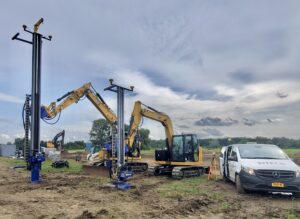How many times have we come to change the bit or strip the Hammer only to find that it cannot be dismantled without extreme difficulty and much effort.
Hammer manufacturers are sometimes at a loss what to do when it comes to thread design. If the threads are of one design they may be hard to unscrew, whilst of another design they may become unscrewed in the hole with the loss of the bit and retaining rings. Either case does not suit the driller.
Most makers opt for a compromise and adopt the 3 start thread arrangement, where there will actually be 3 threads following each other, instead of just the one that is common on a simple bolt and nut.
The 3 start thread makes it easier to unscrew components and if the pitch is right then it is less likely to become unscrewed in the hole, although this can happen in soft ground conditions – usually as the driller attempts to clear a blocked hole – so take care.
Even with a 3 start thread arrangement, the tool that has been on the rig for a time or has been used in difficult ground with a powerful rig, is likely to have screwed up so tight that it is nigh impossible to loosen it.
Drillers then resort to bashing the case around the thread with a sledge hammer that can cause serious damage to this region which may then result in catastrophic cracking of the Wear-Sleeve or Chuck so that the parts then become un-serviceable.
Having the right tools, such as correctly fitting spanners and utilising the hydraulic wrench on the rig or using a purpose made stripping bench, can save a lot of time and money and avoid damaging Hammer components.
Thread lubrication is important too, and if you have hydraulics on the rig, then may be at the end of each shift the Hammer can be loosened (not totally unscrewed) and some new grease applied to the threads to make it easier for when the Hammer has to be completely dismantled or when bit changing time comes along.
Be careful about the kind of grease you use. A metal based grease with Aluminium or Copper with a molybdenum additive is usually fine and will remain on the threads longer than ordinary grease. But remember that a Copper based grease, used where there is acidic water present in the hole, can trigger galvanic action with electrolysis causing decomposition at the root of the threads so that fine cracks will then propagate through the steel to cause major failure around the thread areas.


